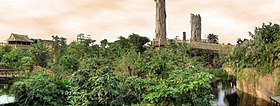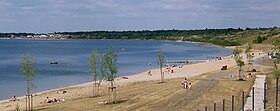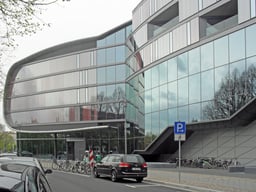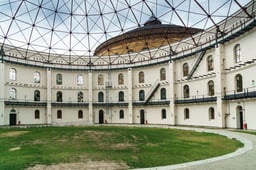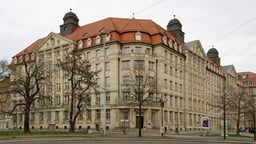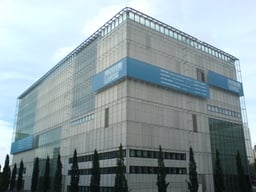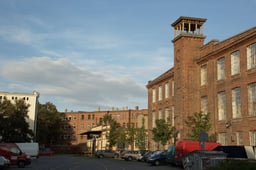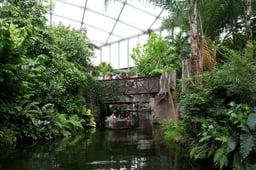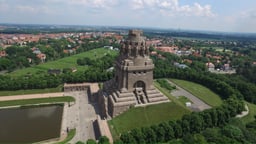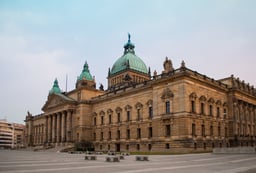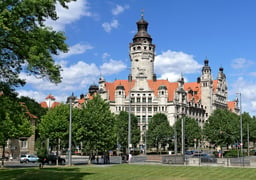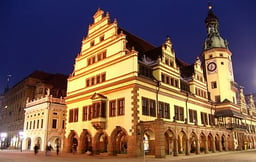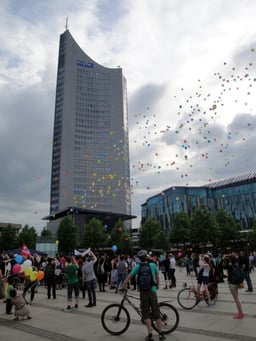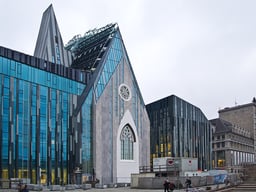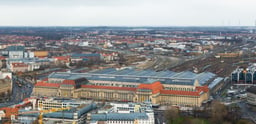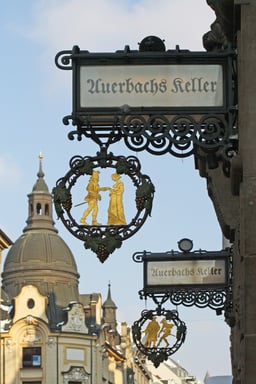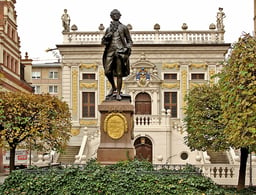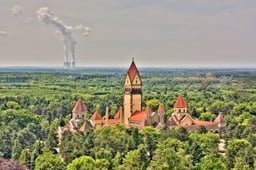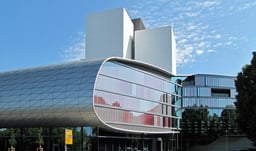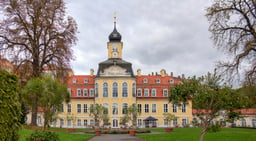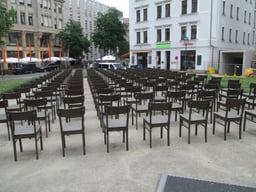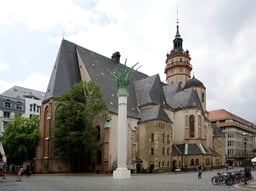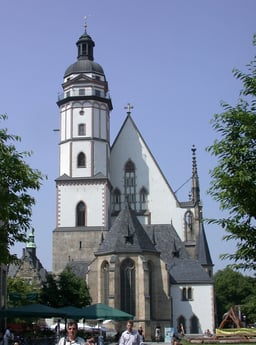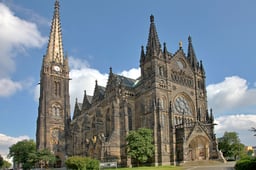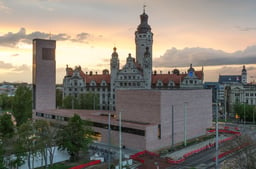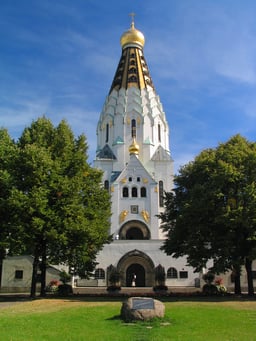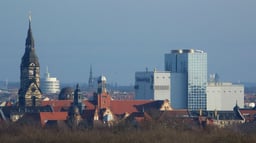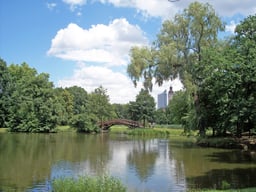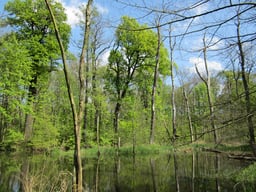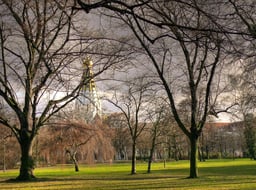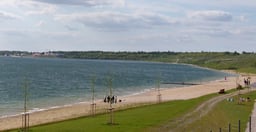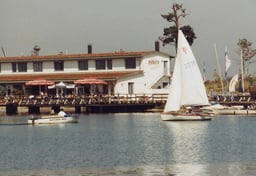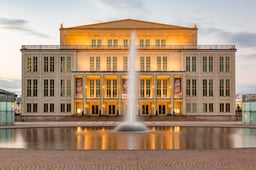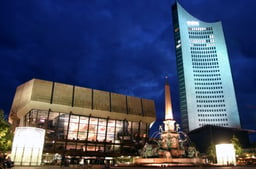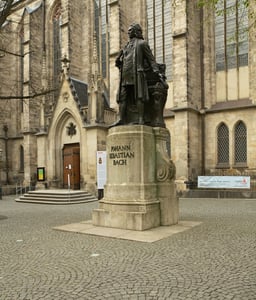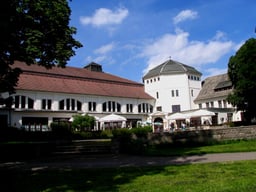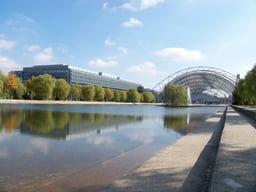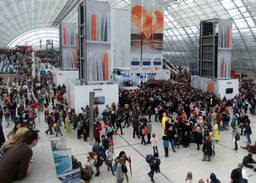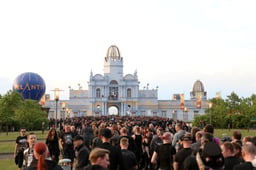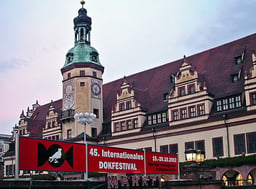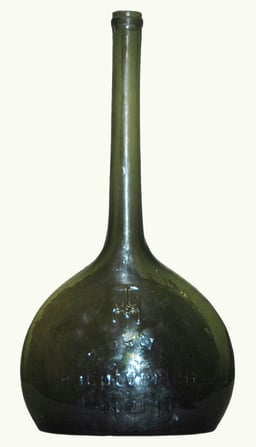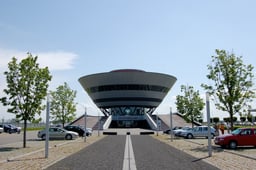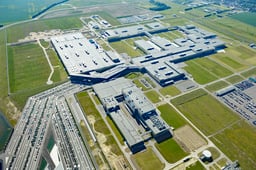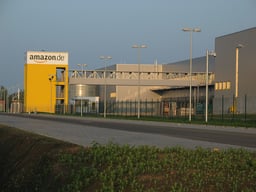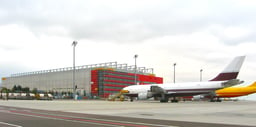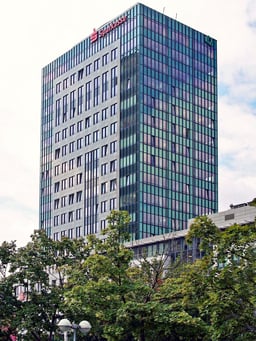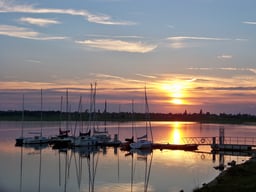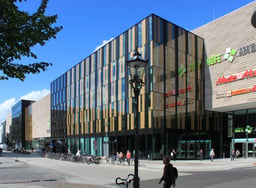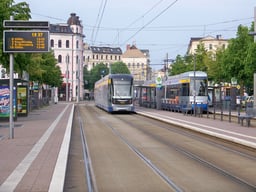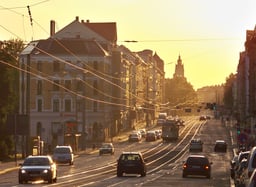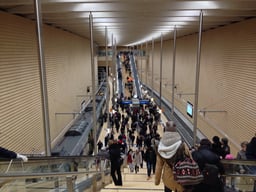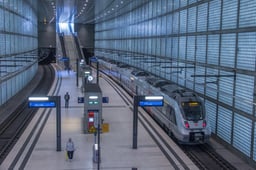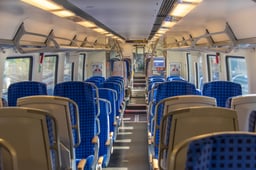Leipzig

Leipzig

Leipzig | |
|---|---|
From top: Skyline of Leipzig centre, Monument to the Battle of the Nations at night, Federal Administrative Court of Germany, New Town Hall, City-Hochhaus Leipzig and the Augusteum of the Leipzig University, inside Gondwanaland of Leipzig Zoological Garden, Markkleeberger See is part of Neuseenland | |
Location of Leipzig | |
| Coordinates:51°20′N 12°23′E [143] | |
| Country | Germany |
| State | Saxony |
| District | Urban districts of Germany |
| Government | |
| • Lord Mayor | Burkhard Jung (SPD) |
| Area | |
| • City | 297.36 km2(114.81 sq mi) |
| Population (2018-12-31)[2] | |
| • City | 587,857 |
| • Density | 2,000/km2(5,100/sq mi) |
| • Metro | 1,001,220 (LUZ)[1] |
| Time zone | CET/CEST (UTC+1/+2) |
| Postal codes | 04001–04357 |
| Dialling codes | 0341 |
| Vehicle registration | L |
| Website | www.leipzig.de [144] |
Leipzig (/ˈlaɪpsɪɡ/, also US: /-(t)sɪk/,[3][4][5] German: [ˈlaɪptsɪç] (listen); Upper and Lower Sorbian: Lipsk; Upper Saxon: Leibzsch) is the most populous city in the German federal state of Saxony. With a population of 587,857 inhabitants as of 2018 (1.1 million[6] residents in the larger urban zone)[1], it is Germany's eighth most populous city[7][8] as well as the second most populous city in the area of former East Germany after (East) Berlin. Together with Halle (Saale), the largest city of the neighbouring state of Saxony-Anhalt, the city forms the polycentric conurbation of Leipzig-Halle. Between the two cities (in Schkeuditz) lies Leipzig/Halle International Airport.
Leipzig is located about 160 kilometres (99 mi) southwest of Berlin in the Leipzig Bay, which constitutes the southernmost part of the North German Plain, at the confluence of the White Elster River (progression: Saale→ Elbe→ North Sea) and two of its tributaries: the Pleiße and the Parthe. The name of the city as well as the names of many of its boroughs are of Slavic origin.
Leipzig has been a trade city since at least the time of the Holy Roman Empire.[9] The city sits at the intersection of the Via Regia and the Via Imperii, two important medieval trade routes. Leipzig was once one of the major European centres of learning and culture in fields such as music and publishing.[10] Leipzig became a major urban centre within the former East Germany after the Second World War, but its cultural and economic importance declined.[10] Events in Leipzig in 1989 played a significant role in precipitating the fall of communism in Central and Eastern Europe, mainly through demonstrations starting from St. Nicholas Church. Since the reunification of Germany, Leipzig has undergone significant change with the restoration of some historical buildings, the demolition of others, and the development of a modern transport infrastructure.[11]
Leipzig today is an economic centre, the most livable city in Germany, according to the GfK marketing research institution and has the second-best future prospects of all cities in Germany, according to HWWI and Berenberg Bank.[12][13] The city is one of two seats of the German National Library (together with Frankfurt), as well as the seat of the German Federal Administrative Court. Leipzig Zoo is one of the most modern zoos in Europe and ranks first in Germany and second in Europe according to Anthony Sheridan.[14][15] Since the opening of the Leipzig City Tunnel in 2013, Leipzig forms the centrepiece of the S-Bahn Mitteldeutschland public transit system.[16] Leipzig is currently listed as a Gamma World City[17], Germany's "Boomtown"[18] and as the European City of the Year 2019.[19][20]
Leipzig has long been a major centre for music, both classical as well as modern "dark alternative music" or darkwave genres. The Oper Leipzig is one of the most prominent opera houses in Germany. It was founded in 1693, making it the third-oldest opera venue in Europe after La Fenice (Venice, Italy) and the Hamburg State Opera (Hamburg, Germany). Leipzig is also home to the University of Music and Theatre "Felix Mendelssohn Bartholdy". It was during a stay in this city that Friedrich Schiller wrote his poem "Ode to Joy". The Leipzig Gewandhaus Orchestra, established in 1743, is one of the oldest symphony orchestras in the world. Johann Sebastian Bach is one among many major composers who lived and worked in Leipzig.
Leipzig | |
|---|---|
From top: Skyline of Leipzig centre, Monument to the Battle of the Nations at night, Federal Administrative Court of Germany, New Town Hall, City-Hochhaus Leipzig and the Augusteum of the Leipzig University, inside Gondwanaland of Leipzig Zoological Garden, Markkleeberger See is part of Neuseenland | |
Location of Leipzig | |
| Coordinates:51°20′N 12°23′E [143] | |
| Country | Germany |
| State | Saxony |
| District | Urban districts of Germany |
| Government | |
| • Lord Mayor | Burkhard Jung (SPD) |
| Area | |
| • City | 297.36 km2(114.81 sq mi) |
| Population (2018-12-31)[2] | |
| • City | 587,857 |
| • Density | 2,000/km2(5,100/sq mi) |
| • Metro | 1,001,220 (LUZ)[1] |
| Time zone | CET/CEST (UTC+1/+2) |
| Postal codes | 04001–04357 |
| Dialling codes | 0341 |
| Vehicle registration | L |
| Website | www.leipzig.de [144] |
History
Name
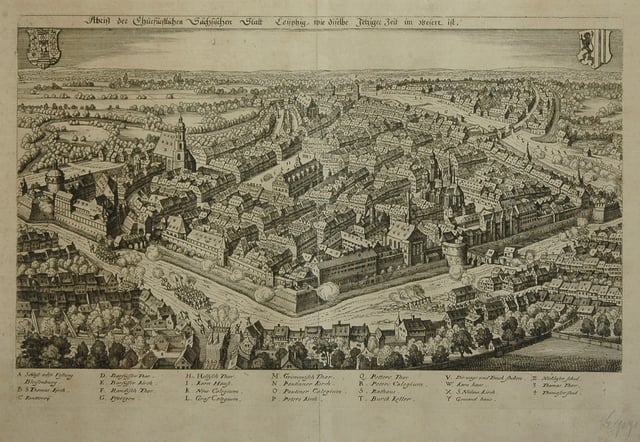
Leipzig in the 17th century
The name Leipzig is derived from the Slavic word Lipsk, which means "settlement where the linden trees (British English: lime trees; U.S. English: basswood trees) stand".[21] An older spelling of the name in English is Leipsic. The Latin name Lipsia was also used.[22] The name is cognate with Lipetsk (Липецк) in Russia and Liepāja in Latvia.[23]
In 1937 the Nazi government officially renamed the city Reichsmessestadt Leipzig (Imperial Trade Fair City Leipzig).[24]
Since 1989 Leipzig has been informally dubbed "Hero City" (Heldenstadt), in recognition of the role that the Monday demonstrations there played in the fall of the East German regime – the name alludes to the honorary title awarded in the former Soviet Union to certain cities that played a key role in the victory of the Allies during the Second World War.[25] The common usage of this nickname for Leipzig up until the present is reflected, for example, in the name of a popular blog for local arts and culture, Heldenstadt.de.[26]
Origins

A map from Meyers Konversations-Lexikon depicting the Battle of Leipzig on 18 October 1813

Battle of Leipzig, 1813
Leipzig was first documented in 1015 in the chronicles of Bishop Thietmar of Merseburg as urbs Libzi (Chronikon VII, 25) and endowed with city and market privileges in 1165 by Otto the Rich. Leipzig Trade Fair, started in the Middle Ages, has become an event of international importance and is the oldest surviving trade fair in the world.
There are records of commercial fishing operations on the river Pleiße in Leipzig dating back to 1305, when the Margrave Dietrich the Younger granted the fishing rights to the church and convent of St Thomas.[31]
There were a number of monasteries in and around the city, including a Franciscan monastery after which the Barfußgäßchen (Barefoot Alley) is named and a monastery of Irish monks (Jacobskirche, destroyed in 1544) near the present day Ranstädter Steinweg (the old Via Regia).
The foundation of the University of Leipzig in 1409 initiated the city's development into a centre of German law and the publishing industry, and towards being the location of the Reichsgericht (Imperial Court of Justice) and the German National Library (founded in 1912).
During the Thirty Years' War, two battles took place in Breitenfeld, about 8 kilometres (5.0 miles) outside Leipzig city walls. The first Battle of Breitenfeld took place in 1631 and the second in 1642. Both battles resulted in victories for the Swedish-led side.
On 24 December 1701, an oil-fueled street lighting system was introduced. The city employed light guards who had to follow a specific schedule to ensure the punctual lighting of the 700 lanterns.
19th century

New City Hall of Leipzig, built in 1905
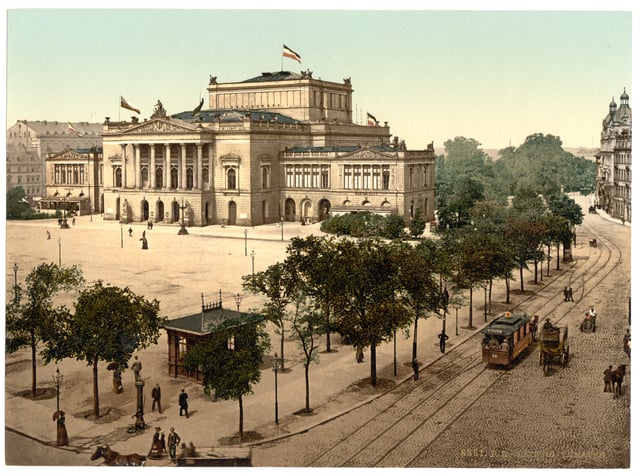
Augustusplatz with Leipzig Opera House, around 1900
The Leipzig region was the arena of the 1813 Battle of Leipzig between Napoleonic France and an allied coalition of Prussia, Russia, Austria and Sweden. It was the largest battle in Europe before the First World War and the coalition victory ended Napoleon's presence in Germany and would ultimately lead to his first exile on Elba. The Monument to the Battle of the Nations celebrating the centenary of this event was completed in 1913. In addition to stimulating German nationalism, the war had a major impact in mobilizing a civic spirit in numerous volunteer activities. Many volunteer militias and civic associations were formed, and collaborated with churches and the press to support local and state militias, patriotic wartime mobilization, humanitarian relief and postwar commemorative practices and rituals.[32]
When it was made a terminus of the first German long-distance railway to Dresden (the capital of Saxony) in 1839, Leipzig became a hub of Central European railway traffic, with Leipzig Hauptbahnhof the largest terminal station by area in Europe. The railway station has two grand entrance halls, the eastern one for the Royal Saxon State Railways and the western one for the Prussian state railways.
In the 19th century, Leipzig was a centre of the German and Saxon liberal movements. The first German labor party, the General German Workers' Association (Allgemeiner Deutscher Arbeiterverein, ADAV) was founded in Leipzig on 23 May 1863 by Ferdinand Lassalle; about 600 workers from across Germany travelled to the foundation on the new railway. Leipzig expanded rapidly to more than 700,000 inhabitants. Huge Gründerzeit areas were built, which mostly survived both war and post-war demolition.
20th century

Leipzig after bombing in the Second World War
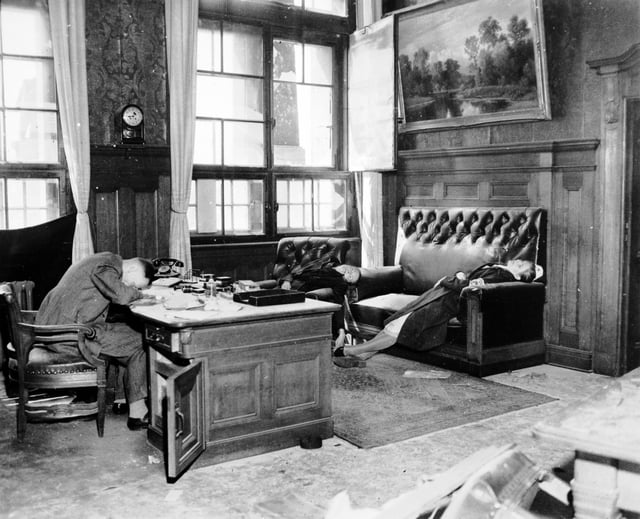
The Lisso family suicide

Major Walter Dönicke committed suicide
With the opening of a fifth production hall in 1907, the Leipziger Baumwollspinnerei became the largest cotton mill company on the continent, housing over 240,000 spindles. Daily production surpassed 5 million kilograms of yarn.[33]
During the 1930s and 1940s, music was prominent throughout Leipzig. Many students attended Felix Mendelssohn Bartholdy College of Music and Theatre (then named Landeskonservatorium.) However, in 1944, it was closed due to World War II. It re-opened soon after the war ended in 1945.
On 22 May 1930, Carl Friedrich Goerdeler was elected mayor of Leipzig. He was well known as an opponent of the Nazi regime.[34] He resigned in 1937 when, in his absence, his Nazi deputy ordered the destruction of the city's statue of Felix Mendelssohn. On Kristallnacht in 1938, the 1855 Moorish Revival Leipzig synagogue, one of the city's most architecturally significant buildings, was deliberately destroyed. Goerdeler was later executed by the Nazis on 2 February 1945.
Several thousand forced labourers were stationed in Leipzig during the Second World War.
Beginning in 1933, many Jewish citizens of Leipzig were members of the Gemeinde, a large Jewish religious community spread throughout Germany, Austria and Switzerland. In October 1935, the Gemeinde helped found the Lehrhaus (English: a house of study) in Leipzig to provide different forms of studies to Jewish students who were prohibited from attending any institutions in Germany. Jewish studies were emphasized and much of the Jewish community of Leipzig became involved.[35]
Like all other cities claimed by the Nazis, Leipzig was subject to aryanisation. Beginning in 1933 and increasing in 1939, Jewish business owners were forced to give up their possessions and stores. This eventually intensified to the point where Nazi officials were strong enough to evict the Jews from their own homes. They also had the power to force many of the Jews living in the city to sell their houses. Many people who sold their homes emigrated elsewhere, outside of Leipzig. Others moved to Judenhäuser, which were smaller houses that acted as ghettos, housing large groups of people.[35]
As with other cities in Europe during the Holocaust, the Jews of Leipzig were greatly affected by the Nuremberg Laws. However, due to the Leipzig Trade Fair and the international attention it garnered, Leipzig was especially cautious about its public image. Despite this, the Leipzig authorities were not afraid to strictly apply and enforce anti-semitic measures.[35] Shortly before Kristallnacht, Polish Jews living in the city were expelled.[35]
On 20 December 1937, after the Nazis took control of the city, they renamed it Reichsmessestadt Leipzig, meaning the "Imperial Trade Fair City Leipzig".[36] In early 1938, Leipzig saw an increase in Zionism through Jewish citizens. Many of these Zionists attempted to flee before deportations began.[35] On 28 October 1938, Heinrich Himmler ordered the deportation of Polish Jews from Leipzig to Poland.[35][37]
On 9 November 1938, as part of Kristallnacht, in Gottschedstrasse (German: Gottschedstraße), now a popular dining and nightlife area in Leipzig, synagogues and businesses were set on fire.[35] Only a couple of days later, on 11 November 1938, many Jews in the Leipzig area were deported to the Buchenwald Concentration Camp.[38] As World War II came to an end, much of Leipzig was destroyed. Following the war, the Communist Party of Germany (German: Kommunistische Partei Deutschlands, KPD) provided aid for the reconstruction of the city.[39]
In 1933, a census recorded that over 11,000 Jews were living in Leipzig. In the 1939 census, the number had fallen to roughly 4,500, and by January 1942 only 2,000 remained. In that month, these 2,000 Jews began to be deported.[35] On 13 July 1942, 170 Jews were deported from Leipzig to Auschwitz Concentration Camp. On 19 September 1942, 440 Jews were deported from Leipzig to Theresienstadt Concentration Camp. On 18 June 1943, the remaining 18 Jews still in Leipzig were deported from Leipzig to Auschwitz Concentration Camp. According to records of the two waves of deportations to Auschwitz there were no survivors. According to records of the Theresienstadt deportation, only 53 Jews survived.[35][40]
Until late 1943, there was little threat of aerial bombings to the city. However, on the morning of 4 December 1943, the British Royal Air Force dropped over 1,000 tons of explosives, resulting in the death of nearly 1,000 civilians.[41] This bombing was the largest up to that time. Due to the close proximity of many of the buildings hit, a firestorm occurred. This prompted firefighters to rush to the city; however, the storm was too overwhelming for them. Unlike its neighbouring city of Dresden, this was a largely conventional bombing with high explosives rather than incendiaries. The resultant pattern of loss was a patchwork, rather than wholesale loss of its centre, but was nevertheless extensive.
The Allied ground advance into Germany reached Leipzig in late April 1945. The U.S. 2nd Infantry Division and U.S. 69th Infantry Division fought their way into the city on 18 April and completed its capture after fierce urban action, in which fighting was often house-to-house and block-to-block, on 19 April 1945.[42] In April 1945 the SS Gruppehfuhrer/Mayor of Leipzig Bruno Erich Alfred Freyberg, his wife and daughter; the Deputy Mayor/Treasurer of Leipzig, Ernest Kurt Lisso, his wife, daughter, and a Volkssturm Major Walter Dönicke committed suicide in Leipzig City Hall.
The United States turned the city over to the Red Army as it pulled back from the line of contact with Soviet forces in July 1945 to the designated occupation zone boundaries. Leipzig became one of the major cities of the German Democratic Republic (East Germany).
In the mid-20th century, the city's trade fair assumed renewed importance as a point of contact with the Comecon Eastern Europe economic bloc, of which East Germany was a member. At this time, trade fairs were held at a site in the south of the city, near the Monument to the Battle of the Nations. In October 1989, after prayers for peace at St. Nicholas Church, established in 1983 as part of the peace movement, the Monday demonstrations started as the most prominent mass protest against the East German government.[44][45] Since the reunification of Germany, Leipzig has undergone significant change with the restoration of some historical buildings, the demolition of others, and the development of a modern transport infrastructure.
21st century
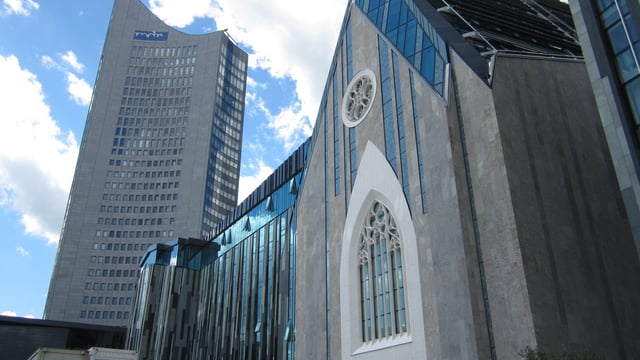
The 153-metre-high City-Hochhaus Leipzig and the Augusteum of the University of Leipzig
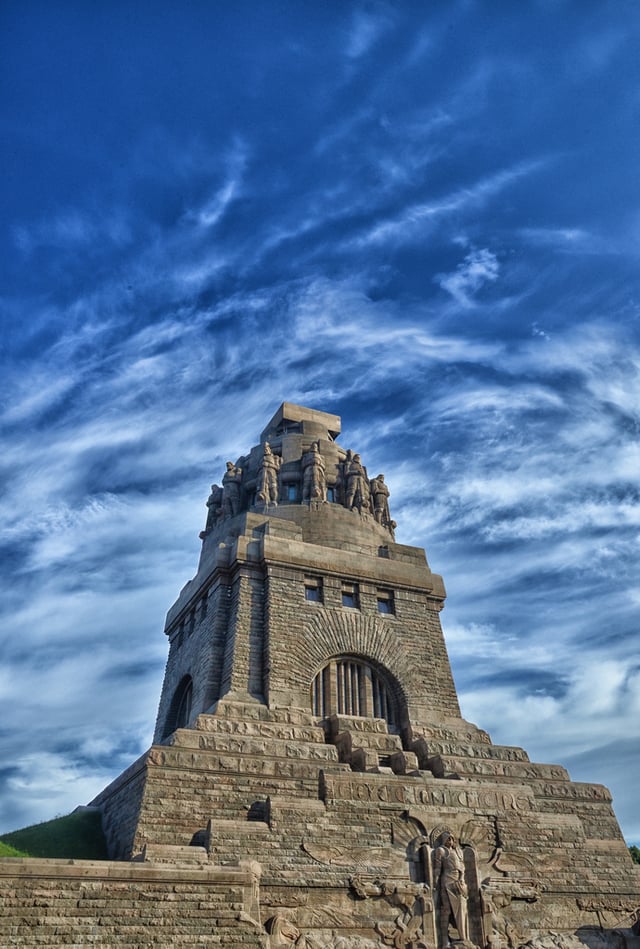
Monument to the Battle of the Nations

Federal Administrative Court of Germany
Nowadays, Leipzig is an important economic center in Germany. Since the 2010s, the city has been celebrated by the media as a hip urban center with a very high quality of living.[46][47][48] It is often called "The new Berlin".[49] Leipzig is also Germany's fastest growing city.[50] Leipzig was the German candidate for the 2012 Summer Olympics, but was unsuccessful. After ten years of construction, the Leipzig City Tunnel opened on 14 December 2013.[51] Leipzig forms the centerpiece of the S-Bahn Mitteldeutschland public transit system, which operates in the four German states of Saxony, Saxony-Anhalt, Thuringia and Brandenburg.
Geography
Location
Leipzig lies at the confluence of the rivers White Elster, Pleiße and Parthe, in the Leipzig Bay, on the most southerly part of the North German Plain, which is the part of the North European Plain in Germany. The site is characterized by swampy areas such as the Leipzig Riverside Forest, though there are also some limestone areas to the north of the city. The landscape is mostly flat though there is also some evidence of moraine and drumlins.
Leipzig is also situated at the intersection of the ancient roads known as the Via Regia (King's highway), which traversed Germany in an east-west direction, and the Via Imperii (Imperial Highway), a north-south road.
Leipzig was a walled city in the Middle Ages and the current "ring" road around the historic centre of the city follows the line of the old city walls.
Subdivision

Stadtteile and regions
Since 1992 Leipzig has been divided administratively into ten districts, which in turn contain a total of 63 subdistricts. Some of these correspond to outlying villages which have been annexed by Leipzig.
| District | Pop. | Area km² | Pop. per km2 |
|---|---|---|---|
| Center | 49,562 | 13,88 | 3,570 |
| Northeast | 41,186 | 26.29 | 1.566 |
| East | 69,666 | 40.74 | 1,710 |
| Southeast | 51,139 | 34.65 | 1,476 |
| South | 57,434 | 16.92 | 3,394 |
| Southwest | 45,886 | 46.67 | 983 |
| West | 51,276 | 14.69 | 3,491 |
| Old West | 46,009 | 26.09 | 1,764 |
| Northwest | 28,036 | 39.09 | 717 |
| North | 57,559 | 38.35 | 1,501 |
Neighbouring communities
Climate
Like many places located in Eastern parts of Germany, Leipzig has an oceanic climate (Köppen: Cfb close to a Dfb [0 °C US isoterm]) with significant continental influences due to inland location. Winters are variably mild to cold, with an average of around 1 °C (34 °F). Summers are generally warm, averaging at 19 °C (66 °F) with daytime temperatures of 24 °C (75 °F). Precipitation in winter is about half that of the summer. The amount of sunshine is very different between winter and summer, with an average of around 51 hours of sunshine in December (1.7 hours a day) compared with 229 hours of sunshine in July (7.4 hours a day).[54]
| Climate data for Leipzig/Halle, Germany for 1981–2010, temperature records for 1973–2013 (Source: DWD) | |||||||||||||
|---|---|---|---|---|---|---|---|---|---|---|---|---|---|
| Month | Jan | Feb | Mar | Apr | May | Jun | Jul | Aug | Sep | Oct | Nov | Dec | Year |
| Record high °C (°F) | 15.9 (60.6) | 18.6 (65.5) | 23.0 (73.4) | 29.5 (85.1) | 31.9 (89.4) | 34.8 (94.6) | 36.6 (97.9) | 37.2 (99.0) | 32.9 (91.2) | 28.2 (82.8) | 18.7 (65.7) | 16.5 (61.7) | 37.2 (99.0) |
| Average high °C (°F) | 3.2 (37.8) | 4.3 (39.7) | 8.7 (47.7) | 13.9 (57.0) | 19.0 (66.2) | 21.7 (71.1) | 24.5 (76.1) | 24.1 (75.4) | 19.3 (66.7) | 14.0 (57.2) | 7.6 (45.7) | 3.6 (38.5) | 13.67 (56.61) |
| Daily mean °C (°F) | 0.5 (32.9) | 1.1 (34.0) | 4.7 (40.5) | 8.9 (48.0) | 13.8 (56.8) | 16.5 (61.7) | 19.0 (66.2) | 18.6 (65.5) | 14.4 (57.9) | 9.8 (49.6) | 4.7 (40.5) | 1.3 (34.3) | 9.45 (49.01) |
| Average low °C (°F) | −2.2 (28.0) | −2.0 (28.4) | 1.1 (34.0) | 4.1 (39.4) | 8.5 (47.3) | 11.5 (52.7) | 13.8 (56.8) | 13.6 (56.5) | 10.1 (50.2) | 6.2 (43.2) | 2.0 (35.6) | −1.2 (29.8) | 5.47 (41.85) |
| Record low °C (°F) | −27.6 (−17.7) | −21.6 (−6.9) | −16.6 (2.1) | −6.5 (20.3) | −2.6 (27.3) | 1.8 (35.2) | 5.7 (42.3) | 5.5 (41.9) | 0.5 (32.9) | −6.7 (19.9) | −12.9 (8.8) | −20.2 (−4.4) | −27.6 (−17.7) |
| Average precipitation mm (inches) | 31.9 (1.26) | 26.3 (1.04) | 38.8 (1.53) | 39.6 (1.56) | 46.9 (1.85) | 54.8 (2.16) | 68.9 (2.71) | 63.1 (2.48) | 49.9 (1.96) | 31.0 (1.22) | 43.4 (1.71) | 39.8 (1.57) | 534.10 (21.03) |
| Mean monthly sunshine hours | 62.8 | 77.8 | 124.5 | 181.7 | 227.4 | 224.8 | 229.0 | 213.1 | 160.9 | 122.9 | 61.5 | 51.1 | 1,737.3 |
| Source: Data derived from Deutscher Wetterdienst, note: sunshine hours are from 1991–2013[55] | |||||||||||||
Demographics

Population development since 1200

Typically dense cityscape of Leipzig old town, view from Neues Rathaus. Buildings from left to right: Gondwanaland of Leipzig Zoo, St. Thomas Church, Highrise of Sparkasse Leipzig Bank, Hotel The Westin Leipzig and Museum of Fine Arts to the right.
Leipzig has a population of about 570,000. In 1930, the population reached its historical peak of over 700,000. It decreased steadily from 1950-89 to about 530,000. In the 1990s, the population decreased rather rapidly to 437,000 in 1998. This reduction was mostly due to outward migration and suburbanisation. After almost doubling the city area by incorporation of surrounding towns in 1999, the number stabilised and started to rise again with an increase of 1,000 in 2000.[56] As of 2015, Leipzig is the fastest-growing city in Germany with over 500,000 inhabitants.[57] The growth of the past 10–15 years has mostly been due to inward migration. In recent years, inward migration accelerated, reaching an increase of 12,917 in 2014.[58]
In the years following German reunification, many people of working age took the opportunity to move to the states of the former West Germany to seek employment opportunities. This was a contributory factor to falling birth rates. Births dropped from 7,000 in 1988 to less than 3,000 in 1994.[59] However, the number of children born in Leipzig has risen since the late-1990s. In 2011, it reached 5,490 births resulting in a RNI of -17.7 (-393.7 in 1995).[60]
The percentage of the population from an immigrant background is low compared with other German cities. As of 2012, only 5.6% of the population were foreigners, compared to the German national average of 7.7%.[64]
The number of people with an immigrant background (immigrants and their children) grew from 49,323 in 2012 to 77,559 in 2016, making them 13.3% of the city's population (Leipzig's population 579,530 in 2016).[65]
The largest minorities (first and second generation) in Leipzig by country of origin in 31.12.2018 are:[66]
| Rank | Ancestry | Total | Foreigners | Germans |
|---|---|---|---|---|
| 1 | 9,059 | 8,523 | 536 | |
| 2 | 8,773 | 3,214 | 5,559 | |
| 3 | 5,019 | 3,006 | 2,013 | |
| 4 | 4,161 | 3,675 | 486 | |
| 5 | 3,491 | 2,245 | 1,246 | |
| 6 | 3,430 | 2,403 | 1,027 | |
| 7 | 2,816 | 2,104 | 712 | |
| 8 | 2,467 | 1,549 | 218 | |
| 9 | 2,244 | 246 | 1,998 | |
| 10 | 2,171 | 1,916 | 255 | |
| 11 | 1,983 | 1,564 | 419 | |
| 12 | 1,814 | 1,349 | 465 | |
| 13 | 1,615 | 1,238 | 377 | |
| 14 | 1,544 | 1,016 | 528 | |
| 15 | 1,465 | 1,254 | 211 |
Culture, sights and cityscape
Architecture

Mädler Passage, one of 24 covered passages in Leipzig city centre
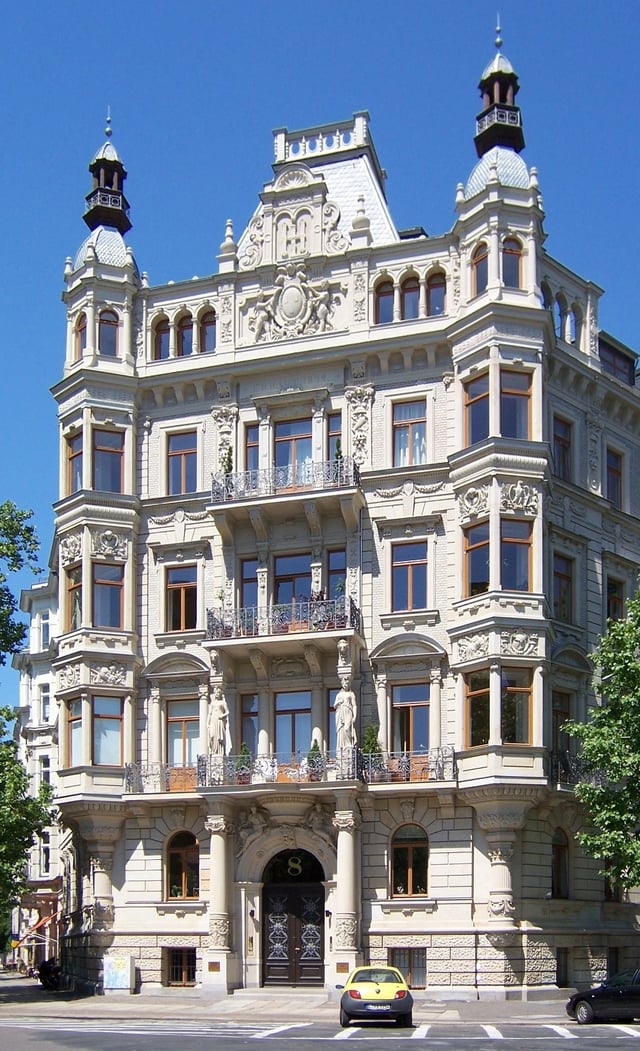
Palais Roßbach, one of the many Gründerzeit buildings in Leipzig
The historic central area of Leipzig features a Renaissance-style ensemble of buildings from the sixteenth century, including the old city hall in the marketplace. There are also several baroque period trading houses and former residences of rich merchants. As Leipzig grew considerably during the economic boom of the late-nineteenth century, the town has many buildings in the historicist style representative of the Gründerzeit era. Approximately 35% of Leipzig's flats are in buildings of this type. The new city hall, completed in 1905, is built in the same style.
Some 64,000 apartments in Leipzig were built in Plattenbau buildings during Communist rule in East Germany.[67] and although some of these have been demolished and the numbers living in this type of accommodation have declined in recent years, at least 10% of Leipzig's population (50,000 people) are still living in Plattenbau accommodation.[68] Grünau, for example, has approximately 40,000 people living in this sort of accommodation.[69]
The St. Paul's Church was destroyed by the Communist government in 1968 to make room for a new main building for the university. After some debate, the city decided to establish a new, mainly secular building at the same location, called Paulinum, which was completed in 2012. Its architecture alludes to the look of the former church and it includes space for religious use by the faculty of theology, including the original altar from the old church and two newly built organs.
Many commercial buildings were built in the 1990s as a result of tax breaks after German reunification.
Tallest buildings and structures
The tallest structure in Leipzig is the chimney of the Stahl- und Hartgusswerk Bösdorf GmbH with a height of 205 metres (673 feet). With 142 metres (466 feet), the City-Hochhaus Leipzig is the tallest high-rise building in Leipzig. From 1972 to 1973 it was Germany's tallest building.
Museums and arts
One of the highlights of the city's contemporary arts was the Neo Rauch retrospective opening in April 2010 at the Leipzig Museum of Fine Arts. This is a show devoted to the father of the New Leipzig School[70][71] of artists. According to The New York Times,[72] this scene "has been the toast of the contemporary art world" for the past decade. In addition, there are eleven galleries in the so-called Spinnerei.[73]
Founded in March 2015, the G2 Kunsthalle houses the Hildebrand Collection.[76] This private collection focuses on the so-called New Leipzig School. Leipzig's first private museum dedicated to contemporary art in Leipzig after the turn of the millennium is located in the city centre close to the famous St. Thomas Church on the third floor of the former GDR processing centre.[77]
Other museums in Leipzig include the following:
The German Museum of Books and Writing is the world's oldest museum of its kind, founded in 1884.
The Egyptian Museum of the University of Leipzig comprises a collection of about 7,000 artefacts from several millennia.
The Schillerhaus is the house where Schiller lived in summer 1785.
The Zeitgeschichtliches Forum Leipzig (Forum of Contemporary History) shows the history of the German division and the everyday life in the communist dictatorship of East Germany.
Naturkundemuseum Leipzig is the city's natural history museum.
The Leipzig Panometer is a visual panorama displayed inside a former gasometer, accompanied by a thematic exhibition.
The "Museum in der Runden Ecke" is the best known museum in the city. It deals with the operation of the Stasi State Security of former East Germany.
Johann Sebastian Bach lived from 1723 until his death in Leipzig. The Bach Archive is an institution for the documentation and research of his life and work.
Main sights
Leipzig Zoological Garden is one of the most modern zoos in Europe with approximately 850 different animal species. It houses the world's largest zoological facilities for primates (Pongoland). Gondwanaland is the world's largest indoor rainforest hall.
Monument to the Battle of the Nations (Völkerschlachtdenkmal) (Battle of the Nations Monument): one of the largest monuments in Europe, built to commemorate the victorious battle against Napoleonic troops.
Bundesverwaltungsgericht: Germany's federal administrative court was the site of the Reichsgericht, the highest state court between 1888-1945.
New City Hall: the city's administrative building was built upon the remains of the Pleissenburg, a castle that was the site of the 1519 debate between Johann Eck and Martin Luther. It is also Germany's tallest town hall.
Old City Hall on Marktplatz: the old city hall was built in 1556 and houses a museum of the city's history.
City-Hochhaus Leipzig: built in 1972, the city's tallest building is one of the top 25 tallest buildings in Germany.[78]
The Augusteum and Paulinum form the new main campus of the University of Leipzig.
international trade fair centre in the north of the city is home to the world's largest levitated glass hall.[79]
Leipzig Hauptbahnhof is the world's largest railway station by floor area and a shopping destination.
Auerbach's Cellar: a young Goethe ate and drank in this basement-level restaurant while studying in Leipzig; it is the venue of a scene from his play Faust.
The Old Leipzig bourse at Naschmarkt with a monument of Johann Wolfgang von Goethe.
South Cemetery (Südfriedhof) is, with an area of 82 hectares, the largest cemetery in Leipzig.
The German National Library has two locations, one of them in Leipzig.
Leipzig Bayerischer Bahnhof is Germany's oldest preserved railway station.
Gohliser Schlösschen
Leipzig Synagogue was destroyed in 1938. Now a memorial stands on the same spot. Where the pews once were, 140 bronze chairs take their place.
Churches
St. Thomas's Church (Thomaskirche): Most famous as the place where Johann Sebastian Bach worked as a cantor and home to the renowned boys choir Thomanerchor. A monument to Felix Mendelssohn stands in front of this church. Destroyed by the Nazis in 1936, the statue was re-erected on 18 October 2008.
St. Nicholas's Church (Nikolaikirche), for which Bach was also responsible. The weekly Montagsgebet (Monday prayer) held here became the starting point of peaceful Monday demonstrations against the DDR regime in the 1980s.
St. Peter's has the highest tower of any church in Leipzig, at 87 metres (285 feet).
The new Propsteikirche, opened in 2015.
The Continental Reformed Church of Leipzig (Evangelisch-reformierte Kirche) is one of the most prominent buildings on the Leipzig Innercity ring.
The Russian Church of Leipzig is the Russian-Orthodox church of Leipzig.
St. Michael's Church is one of the landmarks of Gohlis district.
Parks and lakes
Leipzig is well known for its large parks. The Leipziger Auwald (riparian forest) lies mostly within the city limits. Neuseenland is an area south of Leipzig where old open-cast mines are being converted into a huge lake district. It is planned to be finished in 2060.
Leipzig Botanical Garden is the oldest of its kind in Germany. It contains a total of some 7,000 plant species, of which nearly 3,000 species comprise ten special collections.
Johannapark and Clara-Zetkin-Park are the most prominent parks in the Leipzig city centre.
Leipziger Auwald covers a total area of approx. 2,500 hectares. The Rosental is a park in the north of the forest and borders Leipzig Zoo.
Wildpark in Connewitz, showing 25 species.
Music
Johann Sebastian Bach worked in Leipzig from 1723-50, conducting the Thomanerchor (St. Thomas Church Choir), at the St. Thomas Church, the St. Nicholas Church and the Paulinerkirche, the university church of Leipzig (destroyed in 1968). The composer Richard Wagner was born in Leipzig in 1813, in the Brühl. Robert Schumann was also active in Leipzig music, having been invited by Felix Mendelssohn when the latter established Germany's first musical conservatoire in the city in 1843. Gustav Mahler was second conductor (working under Artur Nikisch) at the Leipzig Opera from June 1886 until May 1888, and achieved his first significant recognition while there by completing and publishing Carl Maria von Weber's opera Die Drei Pintos. Mahler also completed his own 1st Symphony while living in Leipzig.
Today the conservatory is the University of Music and Theatre Leipzig.[80] A broad range of subjects are taught, including artistic and teacher training in all orchestral instruments, voice, interpretation, coaching, piano chamber music, orchestral conducting, choir conducting and musical composition in various musical styles. The drama departments teach acting and scriptwriting.
The Bach-Archiv Leipzig, an institution for the documentation and research of the life and work of Bach (and also of the Bach family), was founded in Leipzig in 1950 by Werner Neumann. The Bach-Archiv organizes the prestigious International Johann Sebastian Bach Competition, initiated in 1950 as part of a music festival marking the bicentennial of Bach's death. The competition is now held every two years in three changing categories. The Bach-Archiv also organizes performances, especially the international festival Bachfest Leipzig (de) and runs the Bach-Museum.
The city's musical tradition is also reflected in the worldwide fame of the Leipzig Gewandhaus Orchestra, under its chief conductor Riccardo Chailly, and the Thomanerchor.
The MDR Leipzig Radio Symphony Orchestra is Leipzig's second largest symphony orchestra. Its current chief conductor is Kristjan Järvi. Both the Gewandhausorchester and the MDR Leipzig Radio Symphony Orchestra make use of in the Gewandhaus concert hall.
For over sixty years Leipzig has been offering a "school concert"[81] programme for children in Germany, with over 140 concerts every year in venues such as the Gewandhaus and over 40,000 children attending.
As for contemporary music, Leipzig is known for its independent music scene and subcultural events. Leipzig has for twenty years been home to the world's largest Gothic festival, the annual Wave-Gotik-Treffen (WGT), where thousands of fans of gothic and dark styled music from across Europe and the world gather in the early summer. The first Wave Gotik Treffen was held at the Eiskeller club, today known as Conne Island, in the Connewitz district. Mayhem's notorious album Live in Leipzig was also recorded at the Eiskeller club.[82] Leipzig Pop Up is an annual music trade fair for the independent music scene as well as a music festival taking place on Pentecost weekend.[83] Its most famous indie-labels are Moon Harbour Recordings (House) and Kann Records (House/Techno/Psychedelic). Several venues offer live music on a daily basis, including the Moritzbastei[84] which was once part of the city's fortifications, and is one of the oldest student clubs in Europe with concerts in various styles. For over 15 years "Tonelli's"[85] has been offering free weekly concerts every day of the week, though door charges may apply Saturdays.
The cover photo for the Beirut band's 2005 album Gulag Orkestar, according to the sleeve notes, was stolen from a Leipzig library by Zach Condon.
The city of Leipzig is also the birthplace of Till Lindemann, best known as the lead vocalist of Rammstein, a band formed in 1994.
Annual events
Auto Mobil International (AMI) motor show[86]
AMITEC, trade fair for vehicle maintenance, care, servicing and repairs in Germany and Central Europe[87]
A cappella: vocal music festival, organized by the Ensemble amarcord
Bach-Fest: Johann Sebastian Bach-festival
Christmas market (since 1767)
Dok Leipzig: international festival for documentary and animated film
Jazztage,[88] contemporary jazz festival
Ladyfest Leipzig[89] (August) Emancipatoric, feminist punk and electro festival
Leipzig Book Fair: the second largest German book fair after Frankfurt
Lichtfest Leipzig, festival celebrating the demonstrations leading up to the collapse of the East German regime
OPER unplugged with Music Dance Theatre by Heike Hennig & Co[90]
Stadtfest: city festival
Wave-Gotik-Treffen at Pentecost: world's largest goth or "dark culture" festival
Leipzig Pop Up[91]
Chaos Communication Congress
Sports
More than 300 sport clubs in the city represent 78 different disciplines. Over 400 athletic facilities are available to citizens and club members.[92]
Football

The Red Bull Arena from above. Home of RB Leipzig.
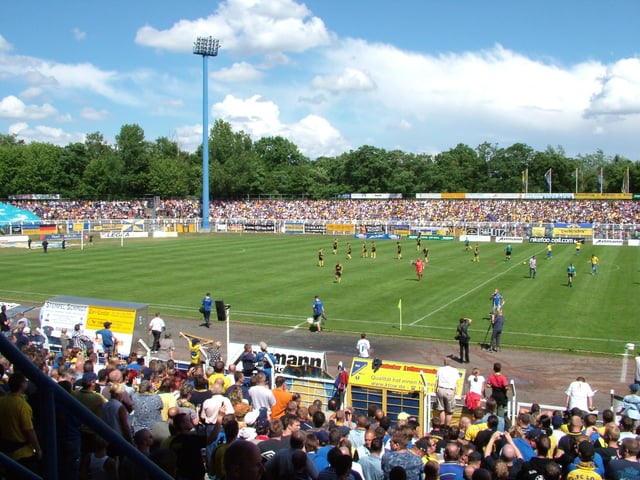
Bruno-Plache-Stadion is the home stadion of 1. FC Lokomotive Leipzig.
The German Football Association (DFB) was founded in Leipzig in 1900. The city was the venue for the 2006 FIFA World Cup draw, and hosted four first-round matches and one match in the round of 16 in the central stadium.
VfB Leipzig, now 1. FC Lokomotive Leipzig, won the first national Association football championship in 1903. The club was reformed as 1. FC Lokomotive Leipzig in 1966 and has had a glorious past in international competition as well, having been champions of the 1965–66 Intertoto Cup, semi-finalists in the 1973–74 UEFA Cup, and runners-up in the 1986–87 European Cup Winners' Cup.
In May 2009 Red Bull entered the local market after being denied the right to buy into FC Sachsen Leipzig in 2006. The newly founded RB Leipzig declared the intention to come up through the ranks of German football to bring Bundesliga football back to the region.[93] RB Leipzig was finally promoted to the top level of the Bundesliga after finishing the 2015–16 2. Bundesliga season as runners-up.
List of Leipzig men and women's football clubs playing at state level and above:
| Club | Founded | League | Level | Home ground | Capacity |
|---|---|---|---|---|---|
| RB Leipzig | 2009 | Bundesliga | 1 | Red Bull Arena | 42,959 |
| RB Leipzig (women) | 20161 | Regionalliga (women) | 3 | Sportanlage Gontardweg | 1,300 |
| 2003 | Regionalliga Nordost | 4 | Bruno-Plache-Stadion | 7,000 |
| BSG Chemie Leipzig | 19972 | NOFV-Oberliga Süd | 5 | Alfred-Kunze-Sportpark | 4,999 |
| FC International Leipzig | 2013 | NOFV-Oberliga Süd | 5 | Sportpark Tresenwald | 1,500 |
| Roter Stern Leipzig (de) | 1999 | Landesklasse Sachsen Nord | 7 | Sportpark Dölitz | 1,200 |
Note 1: The RB Leipzig women's football team was formed in 2016 and began play in the 2016-17 season. Note 2: The club began play in the 2008-09 season.
Ice hockey
Since the beginning of the 20th century Ice hockey gained popularity and several local clubs established departments dedicated to that sport.[94]
Handball
SC DHfK Leipzig is the men's handball club in Leipzig and were six times (1959, 1960, 1961, 1962, 1965 and 1966) the champion of East Germany handball league and was winner of EHF Champions League in 1966. They finally promoted to Handball-Bundesliga as champions of 2. Bundesliga in 2014–15 season. They play in the Arena Leipzig which has a capacity of 6,327 spectators in HBL games but can take up to 7,532 spectators for handball in maximum capacity.
Handball-Club Leipzig is one of the most successful women's handball clubs in Germany, winning 20 domestic championships since 1956 and 3 Champions League titles. The team was however relegated to the third tier league in 2017 due to failing to achieve the economic standard demanded by the league licence.
Other sports
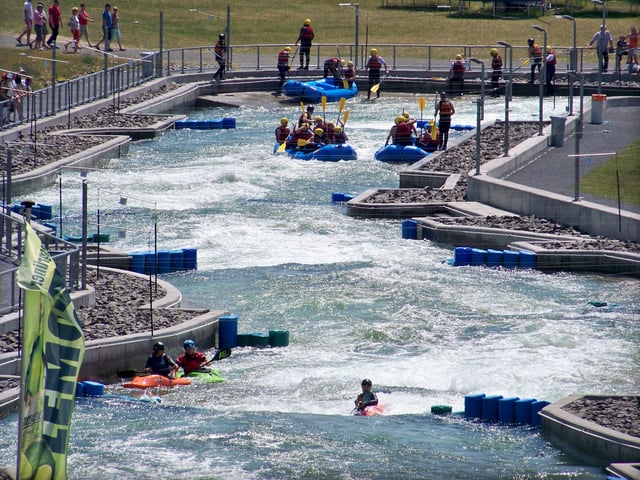
The artificial whitewater course Kanupark Markkleeberg at Markkleeberger See.
From 1950 to 1990 Leipzig was host of the Deutsche Hochschule für Körperkultur (DHfK, German College of Physical Culture), the national sports college of the GDR.
Leipzig also hosted the Fencing World Cup in 2005 and hosts a number of international competitions in a variety of sports each year.
Leipzig made a bid to host the 2012 Summer Olympic Games. The bid did not make the shortlist after the International Olympic Committee pared the bids down to 5.
Markkleeberger See is a new lake next to Markkleeberg, a suburb on the south side of Leipzig. A former open-pit coal mine, it was flooded in 1999 with groundwater and developed in 2006 as a tourist area. On its southeastern shore is Germany's only pump-powered artificial whitewater slalom course, Markkleeberg Canoe Park (Kanupark Markkleeberg), a venue which rivals the Eiskanal in Augsburg for training and international canoe/kayak competition.
Leipzig Rugby Club competes in the German Rugby Bundesliga but finished at the bottom of their group in 2013.[95]
Food and drink
An all-season local dish is Leipziger Allerlei, a stew consisting of seasonal vegetables and crayfish.
Leipziger Lerche is a shortcrust pastry dish filled with crushed almonds, nuts and strawberry jam; the name ("Leipzig lark") comes from a lark pâté which was a Leipzig speciality until the banning of songbird hunting in Saxony in 1876.
Gose is a locally brewed top-fermenting sour beer that originated in the Goslar region and in the 18th century became popular in Leipzig.
Education
University
Leipzig University, founded 1409, is one of Europe's oldest universities. The philosopher and mathematician Gottfried Wilhelm Leibniz was born in Leipzig in 1646, and attended the university from 1661 to 1666. Nobel Prize laureate Werner Heisenberg worked here as a physics professor (from 1927 to 1942), as did Nobel Prize laureates Gustav Ludwig Hertz (physics), Wilhelm Ostwald (chemistry) and Theodor Mommsen (Nobel Prize in literature). Other former staff of faculty include mineralogist Georg Agricola, writer Gotthold Ephraim Lessing, philosopher Ernst Bloch, eccentric founder of psychophysics Gustav Theodor Fechner, and psychologist Wilhelm Wundt. Among the university's many noteworthy students were writers Johann Wolfgang Goethe and Erich Kästner, and philosopher Friedrich Nietzsche, political activist Karl Liebknecht, and composer Richard Wagner. Germany's chancellor since 2006, Angela Merkel, studied physics at Leipzig University.[96] The university has about 30,000 students.
A part of Leipzig University is the German Institute for Literature which was founded in 1955 under the name "Johannes R. Becher-Institut". Many noted writers have graduated from this school, including Heinz Czechowski, Kurt Drawert, Adolf Endler, Ralph Giordano, Kerstin Hensel, Sarah and Rainer Kirsch, Angela Krauß, Erich Loest, Fred Wander. After its closure in 1990 the institute was refounded in 1995 with new teachers.
Visual arts and theatre
The Academy of Visual Arts (Hochschule für Grafik und Buchkunst) was established in 1764. Its 530 students (as of 2006) are enrolled in courses in painting and graphics, book design/graphic design, photography and media art. The school also houses an Institute for Theory.
The University of Music and Theatre offers a broad range of subjects ranging from training in orchestral instruments, voice, interpretation, coaching, piano chamber music, orchestral conducting, choir conducting and musical composition to acting and scriptwriting.
University of Applied Science
The Leipzig University of Applied Sciences (HTWK)[97] has approximately 6,200 students (as of 2007) and is (as of 2007) the second biggest institution of higher education in Leipzig. It was founded in 1992, merging several older schools. As a university of applied sciences (German: Fachhochschule) its status is slightly below that of a university, with more emphasis on the practical part of the education. The HTWK offers many engineering courses, as well as courses in computer science, mathematics, business administration, librarianship, museum studies and social work. It is mainly located in the south of the city.
Leipzig Graduate School
The private Leipzig Graduate School of Management, (in German Handelshochschule Leipzig (HHL)), is the oldest business school in Germany. According to The Economist, HHL is one of the best schools in the world, rankend at number six overall.[98][99]
Research Institutes

The Max Planck Institute for Mathematics in the Sciences
Leipzig is currently the home of twelve research institutes and the Saxon Academy of Sciences and Humanities.
Max Planck Society: Max Planck Institute for Mathematics in the Sciences, Max Planck Institute for Human Cognitive and Brain Sciences, and Max Planck Institute for Evolutionary Anthropology.
Fraunhofer Society institutes: Fraunhofer IZI and Fraunhofer IMW.
Helmholtz Association of German Research Centres: Helmholtz Centre for Environmental Research
Deutsches Biomasseforschungszentrum – DBFZ
Leibniz Association: Leibniz-Institute for Tropospheric Research, Leibniz-Institute IOM, Leibniz-Institute GWZO, Leibniz-Institute IfL, Leibniz-Institute Jewish history.
Others
Leipzig is home to one of the world's oldest schools Thomasschule zu Leipzig (St. Thomas' School, Leipzig), which gained fame for its long association with the Bach family of musicians and composers.
Economy
The city is a location for automobile manufacturing by BMW and Porsche in large plants north of the city. In 2011 and 2012 DHL transferred the bulk of its European air operations from Brussels Airport to Leipzig/Halle Airport. Kirow Ardelt AG, the world market leader in breakdown cranes, is based in Leipzig. The city also houses the European Energy Exchange, the leading energy exchange in Central Europe. With VNG – Verbundnetz Gas AG, one of Germany's large natural gas suppliers is headquartered at Leipzig. In addition, inside its larger metropolitan area, Leipzig has developed an important petrochemical center.
Some of the largest employers in the area (outside of manufacturing) include software companies such as Spreadshirt and the various schools and universities in and around the Leipzig/Halle region. The University of Leipzig attracts millions of euros of investment yearly and is in the middle of a massive construction and refurbishment to celebrate its 600th anniversary.
Leipzig also benefits from world leading medical research (Leipzig Heart Centre) and a growing biotechnology industry.[103]
Many bars, restaurants and stores found in the downtown area are patronized by German and foreign tourists. Leipzig Hauptbahnhof itself is the location of a shopping mall.[104] Leipzig is one of Germany's most visited cities with over 3 million overnight stays in 2017.[105]
In 2010, Leipzig was included in the top 10 cities to visit by The New York Times,[72] and ranked 39th globally out of 289 cities for innovation in the 4th Innovation Cities Index published by Australian agency 2thinknow.[106] In 2015, Leipzig have among the 30 largest German cities the third best prospects for the future.[107] In recent years Leipzig has often been nicknamed the "Boomtown of eastern Germany" or "Hypezig".[28] As of 2013 it had the highest rate of population growth of any German city.[29]
Companies with operations in or around Leipzig include:
Blüthner: piano-manufacturing
BMW
DHL
Porsche
Siemens
Future Electronics
Media
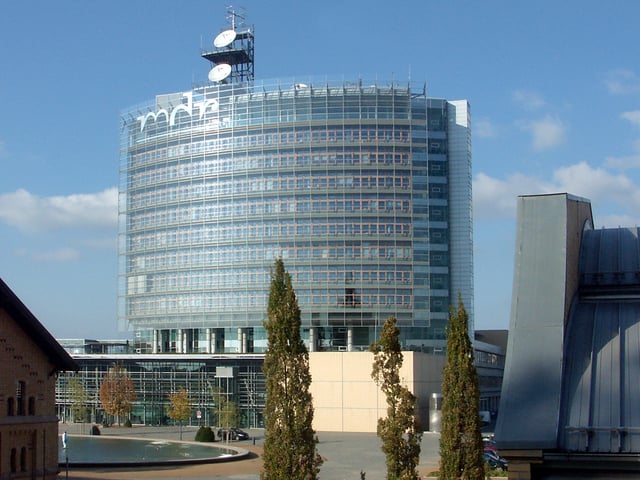
MDR, one of Germany's public broadcasters
MDR, one of Germany's public broadcasters, has its headquarters and main television studios in the city. It provides programmes to various TV and radio networks and has its own symphony orchestra, choir and a ballet.
Leipziger Volkszeitung (LVZ) is the city's only daily newspaper. Founded in 1894, it has published under several different forms of government. The monthly magazine Kreuzer specializes in culture, festivities and the arts in Leipzig. Leipzig was also home to the world's first daily newspaper in modern times. The "Einkommende Zeitungen" were first published in 1650.[108]
Leipzig has one daily or semi-daily English-language publication, "The Leipzig Glocal." It is an online-based magazine and blog that caters to an international as well as local audience.[109] Besides publishing pages on jobs, doctors and movies available in English and other languages, the site's team of authors writes articles about lifestyle, arts & culture, politics, entertainment, Leipzig events, etc.[110]
Once known for its large number of publishing houses, Leipzig had been called Buch-Stadt (book city).,[111] the most notable of them being branches of Brockhaus and Insel Verlag. Few are left after the years of economic decline during the German Democratic Republic, during which time Frankfurt developed as a much more important publishing center. Reclam, founded in 1828, was one of the large publishing houses to move away. Leipzig still has a book fair, but Frankfurt's is far bigger.
The German Library (Deutsche Bücherei) in Leipzig is part of Germany's National Library. Its task is to collect a copy of every book published in German.[112]
Quality of life

Leipzig has the most attractive inner city of all large German cities.
In December 2013, according to a study by Marktforschungsinstituts GfK, Leipzig was ranked as the most livable city in Germany[13][113] and is one of the three European cities with the highest quality of living (after Groningen and Kraków).[114] In 2015/2016, Leipzig was named the second-best city for students in Germany (after Munich).[115]
It also has the second-best future prospects of all cities in Germany, only surpassed by Munich.[12]
According to the 2017 Global Least & Most Stressful Cities Ranking, Leipzig was one of the least stressful cities in the World. It was ranked 25th out of 150 cities worldwide and above Dortmund, Cologne, Frankfurt, and Berlin.[118]
In 2018, Leipzig won the European Cities of Future prize in the category of "Best Large City for Human Capital & Lifestyle".[119]
Leipzig was named European City of the Year at the 2019 Urbanism Awards.[120]
Transport
Founded at the crossing of Via Regia and Via Imperii, Leipzig has been a major interchange of inter-European traffic and commerce since medieval times. After the Reunification of Germany, immense efforts to restore and expand the traffic network have been undertaken and left the city area with an excellent infrastructure.
Rail

Leipzig Hauptbahnhof is the main hub of tram and rail network and the world's largest railway station by floor area.
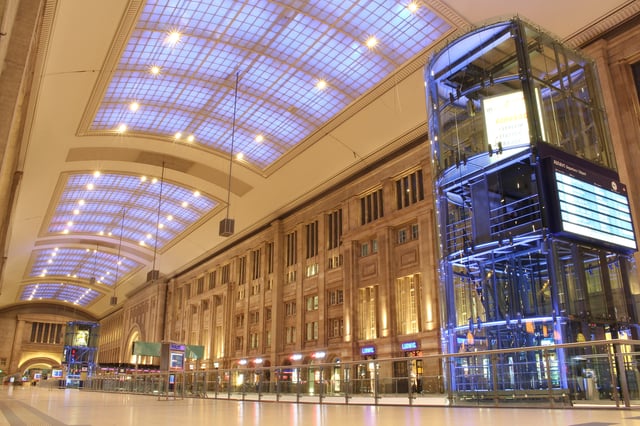
Inside Leipzig main station.
Opened in 1915, Leipzig Central Station is the largest overhead railway station in Europe in terms of its built-up area. At the same time, it is an important supra-regional junction in the ICE and Intercity network of the Deutsche Bahn as well as a connection point for S-Bahn and regional traffic in the Halle/Leipzig area.
In Leipzig, the Intercity Express routes (Hamburg-)Berlin-Leipzig-Nuremberg-Munich and Dresden-Leipzig-Erfurt-Frankfurt am Main-(Wiesbaden/Saarbrücken) intersect. After completion of the high-speed line to Erfurt, the ICE will run on both lines via Leipzig/Halle Airport and Erfurt. Leipzig is also the starting point for the intercity lines Leipzig-Halle (Saale)-Magdeburg-Braunschweig-Hannover-Dortmund-Köln and -Bremen-Oldenburg(-Norddeich Mole). Both lines complement each other at hourly intervals and also stop at Leipzig/Halle Airport. The only international connection is the daily EuroCity Leipzig-Prague.
Most major and medium-sized towns in Saxony and southern Saxony-Anhalt can be reached without changing trains. There are also direct connections via regional express lines to Falkenberg/Elster-Cottbus, Hoyerswerda and Dessau-Magdeburg as well as Chemnitz. Neighbouring Halle (Saale) can be reached via two S-Bahn lines, one of which runs hourly via Leipzig/Halle Airport. The surrounding area of Leipzig is served by numerous regional and S-Bahn lines.
The city's rail connections are currently being greatly improved by major construction projects, particularly within the framework of the German Unity transport projects. The line to Berlin has been extended and has been passable at 200 km/h since 2006. On 13 December 2015, the high-speed line from Leipzig to Erfurt, designed for 300 km/h, was put into operation. Its continuation to Nuremberg is scheduled for completion in December 2017. This integration into the high-speed network will considerably reduce the journey times of the ICE from Leipzig to Nuremberg, Munich and Frankfurt am Main. The Leipzig-Dresden railway line, which was the first German long-distance railway to go into operation in 1839, is also undergoing expansion for 200 km/h. The ICE will also be able to operate from Leipzig to Dresden in the near future. The most important construction project in regional transport was the four-kilometer-long City Tunnel, which went into operation in December 2013 as the main line of the S-Bahn Mitteldeutschland.
For freight traffic, there are freight stations in the districts of Wahren and Engelsdorf. In addition, a large freight traffic centre has been set up near the Schkeuditzer Kreuz junction for goods handling between road and rail, as well as a freight station on the site of the DHL hub at Leipzig/Halle Airport.
Suburban train

Trains of S-Bahn Mitteldeutschland at Leipzig Markt station.
Leipzig is the core of the S-Bahn Mitteldeutschland line network. Together with the tram, six of the ten lines form the backbone of local public transport and an important link to the region and the neighbouring Halle. The main line of the S-Bahn consists of the underground S-Bahn stations Hauptbahnhof, Markt, Wilhelm-Leuschner-Platz and Bayerischer Bahnhof leading through the City Tunnel as well as the above-ground station Leipzig MDR. There are a total of 30 S-Bahn stations in the Leipzig city area. Endpoints of the S-Bahn lines include Oschatz, Zwickau, Geithain and Bitterfeld. Two lines run to Halle, one of them via Leipzig/Halle Airport. In 2015, the network will be extended to Dessau and Lutherstadt Wittenberg.
With the timetable change in December 2004, the networks of Leipzig and Halle were combined to form the Leipzig-Halle S-Bahn. However, this network only served as a transitional solution and was replaced by the S-Bahn Mitteldeutschland on 15 December 2013. At the same time, the main line tunnel, marketed as the Leipzig City Tunnel, went into operation. The tunnel, which is almost four kilometres long, crosses the entire city centre from the main railway station to the Bavarian railway station. The S-Bahn stations are up to 22 metres underground. This construction was the first to create a continuous north-south axis, which had not existed until now due to the north-facing terminus station. The connection to the south of the city and the federal state will thus be greatly improved.
Tramway and Buses
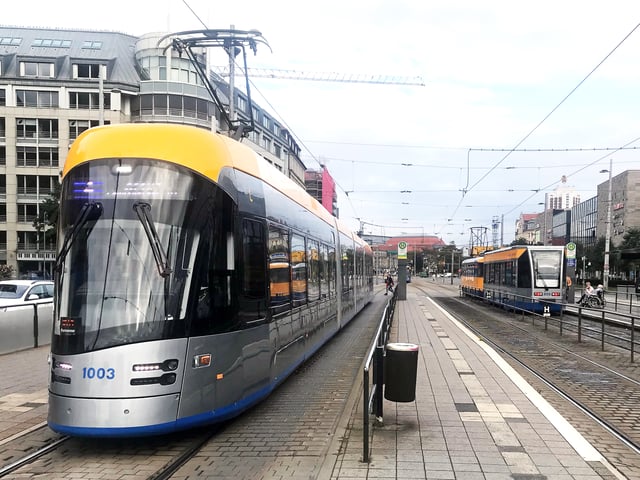
Tram at Goerdelerring.
The Leipziger Verkehrsbetriebe, existing since 1 January 1917, operate a total of 13 tram lines and 51 bus lines in the city.
The total length of the tram network is 149.9 km, making it the largest in Saxony (130.2 km) ahead of Dresden and the second largest in Germany (193.6 km after Berlin). The longest line in the Leipzig network is line 11, which connects Schkeuditz with Markkleeberg over 22 kilometres and is the only tram line in Leipzig to run in three tariff zones of the Central German Transport Association.
Night bus lines N1 to N9 and the night tram N17 operate in the night traffic. On Saturdays, Sundays and holidays the tram line N10 and the bus line N60 also operate. The central transfer point between the bus and tram lines as well as to the S-Bahn is Leipzig Central Station.
Bicycle
Like most German cities, Leipzig has a traffic layout designed to be bicycle-friendly. There is an extensive cycle network. In most of the one-way central streets, cyclists are explicitly allowed to cycle both ways. A few cycle paths have been built or declared since 1990.
Since 2004 there is a bicycle-sharing system. Bikes can be borrowed and returned via smartphone app or by telephone. Since 2018, the system has enabled flexible borrowing and returning of bicycles in the inner city; in this zone, bicycles can be handed in and borrowed from almost any street corner. Outside these zones, there are stations where the bikes are waiting. The current locations of the bikes can be seen via the app. There are cooperation offers with the Leipzig public transport companies and car sharing in order to offer as complete a mobility chain as possible.
Road

Leipzig's road network

Leipzig/Halle Airport, hub of DHL
Several federal motorways pass by Leipzig: the A 14 in the north, the A 9 in the west and the A 38 in the south. The three motorways form a triangular partial ring of the double ring Mitteldeutsche Schleife around Halle and Leipzig. To the south towards Chemnitz, the A 72 is also partly under construction or being planned.
The federal roads B 2, B 6, B 87, B 181, B 184 and B 186 lead through the city area.
The ring, which corresponds to the course of the old city fortification, surrounds the city centre of Leipzig, which today is largely traffic-calmed.
Leipzig has a dense network of carsharing stations. Additionally, since 2018 there is also a stationless car sharing system in Leipzig. Here the cars can be parked and booked anywhere in the inner city without having to define a specific car or period in advance. Finding and booking is done via a smartphone app.
Apart from the usual taxi traffic, Leipzig is one of the few cities in Germany with a ridesharing provider. Taxi-like rides can be booked via an app. However, in contrast to a taxi, the start and destination must be defined beforehand and other passengers can be taken along at the same time if they share a route.
Long-distance buses
Since March 2018 there has been a central bus station directly east of Leipzig Central Station.
In addition to a large number of national lines, several international lines also serve Leipzig. The cities of Bregenz, Budapest, Milan, Prague, Sofia and Zurich, among others, can be reached without having to change trains. Around 30,000 journeys and 1.5 million passengers a year are expected at the new bus station.
Some lines also use Leipzig/Halle Airport, located at the A 9/A 14 motorway junction, and Leipziger Messe for a stop. Passengers can take the S-Bahn from there to the city centre.
Air
Leipzig/Halle Airport is the international commercial airport of the region. It is located at the Schkeuditzer Kreuz junction northwest of Leipzig, halfway between the two major cities. The easternmost section of the new Erfurt-Leipzig/Halle line under construction gave the airport a long-distance railway station, which was also integrated into the ICE network when the railway line was completed in 2015.
Passenger flights are operated to the major German hub airports, European metropolises and holiday destinations, especially in the Mediterranean region and North Africa. The airport is of international importance in the cargo sector. In Germany, it ranks second behind Frankfurt am Main, fifth in Europe and 26th worldwide (as of 2011). DHL uses the airport as its central European hub. It is also the home base of the freight airlines Aerologic and European Air Transport Leipzig.
The former military airport near Altenburg, Thuringia called Leipzig-Altenburg Airport about a half-hour drive from Leipzig was served by Ryanair until 2010.
Water

Boats at the Elsterflutbett
In the first half of the 20th century, the construction of the Elster-Saale canal, White Elster and Saale was started in Leipzig in order to connect to the network of waterways. The outbreak of the Second World War stopped most of the work, though some may have continued through the use of forced labor. The Lindenauer port was almost completed but not yet connected to the Elster-Saale and Karl-Heine canal respectively. The Leipzig rivers (White Elster, New Luppe, Pleiße, and Parthe) in the city have largely artificial river beds and are supplemented by some channels. These waterways are suitable only for small leisure boat traffic.
Through the renovation and reconstruction of existing mill races and watercourses in the south of the city and flooded disused open cast mines, the city's navigable water network is being expanded. The city commissioned planning for a link between Karl Heine Canal and the disused Lindenauer port in 2008. Still more work was scheduled to complete the Elster-Saale canal. Such a move would allow small boats to reach the Elbe from Leipzig. The intended completion date has been postponed because of an unacceptable cost-benefit ratio.
Quotations
Mein Leipzig lob' ich mir! Es ist ein klein Paris und bildet seine Leute. (I praise my Leipzig! It is a small Paris and educates its people.) – Frosch, a university student in Goethe's Faust, Part One
Ich komme nach Leipzig, an den Ort, wo man die ganze Welt im Kleinen sehen kann. (I'm coming to Leipzig, to the place where one can see the whole world in miniature.) – Gotthold Ephraim Lessing
Extra Lipsiam vivere est miserrime vivere. (To live outside Leipzig is to live miserably.) – Benedikt Carpzov the Younger
Das angenehme Pleis-Athen, Behält den Ruhm vor allen, Auch allen zu gefallen, Denn es ist wunderschön. (The pleasurable Pleiss-Athens, earns its fame above all, appealing to every one, too, for it is mightily beauteous.) – Johann Sigismund Scholze
International relations

Plaque on Leipzig Street in Kiev, one of Leipzig's twin towns
Leipzig is twinned with:[123]
[[INLINE_IMAGE|//upload.wikimedia.org/wikipedia/commons/thumb/7/71/Flag_of_Ethiopia.svg/23px-Flag_of_Ethiopia.svg.png|//upload.wikimedia.org/wikipedia/commons/thumb/7/71/Flag_of_Ethiopia.svg/35px-Flag_of_Ethiopia.svg.png 1.5x, //upload.wikimedia.org/wikipedia/commons/thumb/7/71/Flag_of_Ethiopia.svg/46px-Flag_of_Ethiopia.svg.png 2x|Ethiopia|h12|w23|thumbborder flagicon-img flagicon-img]] Addis Ababa, Ethiopia, since 2004
[[INLINE_IMAGE|//upload.wikimedia.org/wikipedia/en/thumb/a/ae/Flag_of_the_United_Kingdom.svg/23px-Flag_of_the_United_Kingdom.svg.png|//upload.wikimedia.org/wikipedia/en/thumb/a/ae/Flag_of_the_United_Kingdom.svg/35px-Flag_of_the_United_Kingdom.svg.png 1.5x, //upload.wikimedia.org/wikipedia/en/thumb/a/ae/Flag_of_the_United_Kingdom.svg/46px-Flag_of_the_United_Kingdom.svg.png 2x|United Kingdom|h12|w23|thumbborder flagicon-img flagicon-img]] Birmingham, UK, since 1992[124]
[[INLINE_IMAGE|//upload.wikimedia.org/wikipedia/en/thumb/0/03/Flag_of_Italy.svg/23px-Flag_of_Italy.svg.png|//upload.wikimedia.org/wikipedia/en/thumb/0/03/Flag_of_Italy.svg/35px-Flag_of_Italy.svg.png 1.5x, //upload.wikimedia.org/wikipedia/en/thumb/0/03/Flag_of_Italy.svg/45px-Flag_of_Italy.svg.png 2x|Italy|h15|w23|thumbborder flagicon-img flagicon-img]] Bologna, Italy, since 1962, renewed in 1997
[[INLINE_IMAGE|//upload.wikimedia.org/wikipedia/commons/thumb/c/cb/Flag_of_the_Czech_Republic.svg/23px-Flag_of_the_Czech_Republic.svg.png|//upload.wikimedia.org/wikipedia/commons/thumb/c/cb/Flag_of_the_Czech_Republic.svg/35px-Flag_of_the_Czech_Republic.svg.png 1.5x, //upload.wikimedia.org/wikipedia/commons/thumb/c/cb/Flag_of_the_Czech_Republic.svg/45px-Flag_of_the_Czech_Republic.svg.png 2x|Czech Republic|h15|w23|thumbborder flagicon-img flagicon-img]] Brno, Czech Republic, since 1973, renewed in 1999[125]
[[INLINE_IMAGE|//upload.wikimedia.org/wikipedia/en/thumb/b/ba/Flag_of_Germany.svg/23px-Flag_of_Germany.svg.png|//upload.wikimedia.org/wikipedia/en/thumb/b/ba/Flag_of_Germany.svg/35px-Flag_of_Germany.svg.png 1.5x, //upload.wikimedia.org/wikipedia/en/thumb/b/ba/Flag_of_Germany.svg/46px-Flag_of_Germany.svg.png 2x|Germany|h14|w23|thumbborder flagicon-img flagicon-img]] Frankfurt am Main, Germany, since 1990[126]
[[INLINE_IMAGE|//upload.wikimedia.org/wikipedia/en/thumb/b/ba/Flag_of_Germany.svg/23px-Flag_of_Germany.svg.png|//upload.wikimedia.org/wikipedia/en/thumb/b/ba/Flag_of_Germany.svg/35px-Flag_of_Germany.svg.png 1.5x, //upload.wikimedia.org/wikipedia/en/thumb/b/ba/Flag_of_Germany.svg/46px-Flag_of_Germany.svg.png 2x|Germany|h14|w23|thumbborder flagicon-img flagicon-img]] Hanover, Germany, since 1987[127]
[[INLINE_IMAGE|//upload.wikimedia.org/wikipedia/commons/thumb/d/d4/Flag_of_Israel.svg/21px-Flag_of_Israel.svg.png|//upload.wikimedia.org/wikipedia/commons/thumb/d/d4/Flag_of_Israel.svg/32px-Flag_of_Israel.svg.png 1.5x, //upload.wikimedia.org/wikipedia/commons/thumb/d/d4/Flag_of_Israel.svg/41px-Flag_of_Israel.svg.png 2x|Israel|h15|w21|thumbborder flagicon-img flagicon-img]] Herzliya, Israel, since 2010
[[INLINE_IMAGE|//upload.wikimedia.org/wikipedia/en/thumb/a/a4/Flag_of_the_United_States.svg/23px-Flag_of_the_United_States.svg.png|//upload.wikimedia.org/wikipedia/en/thumb/a/a4/Flag_of_the_United_States.svg/35px-Flag_of_the_United_States.svg.png 1.5x, //upload.wikimedia.org/wikipedia/en/thumb/a/a4/Flag_of_the_United_States.svg/46px-Flag_of_the_United_States.svg.png 2x|United States|h12|w23|thumbborder flagicon-img flagicon-img]] Houston, United States, since 1993
[[INLINE_IMAGE|//upload.wikimedia.org/wikipedia/commons/thumb/4/49/Flag_of_Ukraine.svg/23px-Flag_of_Ukraine.svg.png|//upload.wikimedia.org/wikipedia/commons/thumb/4/49/Flag_of_Ukraine.svg/35px-Flag_of_Ukraine.svg.png 1.5x, //upload.wikimedia.org/wikipedia/commons/thumb/4/49/Flag_of_Ukraine.svg/45px-Flag_of_Ukraine.svg.png 2x|Ukraine|h15|w23|thumbborder flagicon-img flagicon-img]] Kiev, Ukraine, since 1961, renewed in 1992
[[INLINE_IMAGE|//upload.wikimedia.org/wikipedia/en/thumb/1/12/Flag_of_Poland.svg/23px-Flag_of_Poland.svg.png|//upload.wikimedia.org/wikipedia/en/thumb/1/12/Flag_of_Poland.svg/35px-Flag_of_Poland.svg.png 1.5x, //upload.wikimedia.org/wikipedia/en/thumb/1/12/Flag_of_Poland.svg/46px-Flag_of_Poland.svg.png 2x|Poland|h14|w23|thumbborder flagicon-img flagicon-img]] Kraków, Poland, since 1973, renewed in 1995[123][128][129]
[[INLINE_IMAGE|//upload.wikimedia.org/wikipedia/en/thumb/c/c3/Flag_of_France.svg/23px-Flag_of_France.svg.png|//upload.wikimedia.org/wikipedia/en/thumb/c/c3/Flag_of_France.svg/35px-Flag_of_France.svg.png 1.5x, //upload.wikimedia.org/wikipedia/en/thumb/c/c3/Flag_of_France.svg/45px-Flag_of_France.svg.png 2x|France|h15|w23|thumbborder flagicon-img flagicon-img]] Lyon, France, since 1981[130]
[[INLINE_IMAGE|//upload.wikimedia.org/wikipedia/commons/thumb/f/fa/Flag_of_the_People%27s_Republic_of_China.svg/23px-Flag_of_the_People%27s_Republic_of_China.svg.png|//upload.wikimedia.org/wikipedia/commons/thumb/f/fa/Flag_of_the_People%27s_Republic_of_China.svg/35px-Flag_of_the_People%27s_Republic_of_China.svg.png 1.5x, //upload.wikimedia.org/wikipedia/commons/thumb/f/fa/Flag_of_the_People%27s_Republic_of_China.svg/45px-Flag_of_the_People%27s_Republic_of_China.svg.png 2x|China|h15|w23|thumbborder flagicon-img flagicon-img]] Nanjing, China, since 1988
[[INLINE_IMAGE|//upload.wikimedia.org/wikipedia/commons/thumb/5/5c/Flag_of_Greece.svg/23px-Flag_of_Greece.svg.png|//upload.wikimedia.org/wikipedia/commons/thumb/5/5c/Flag_of_Greece.svg/35px-Flag_of_Greece.svg.png 1.5x, //upload.wikimedia.org/wikipedia/commons/thumb/5/5c/Flag_of_Greece.svg/45px-Flag_of_Greece.svg.png 2x|Greece|h15|w23|thumbborder flagicon-img flagicon-img]] Thessaloniki, Greece, since 1984[131]
[[INLINE_IMAGE|//upload.wikimedia.org/wikipedia/commons/thumb/b/bf/Flag_of_Bosnia_and_Herzegovina.svg/23px-Flag_of_Bosnia_and_Herzegovina.svg.png|//upload.wikimedia.org/wikipedia/commons/thumb/b/bf/Flag_of_Bosnia_and_Herzegovina.svg/35px-Flag_of_Bosnia_and_Herzegovina.svg.png 1.5x, //upload.wikimedia.org/wikipedia/commons/thumb/b/bf/Flag_of_Bosnia_and_Herzegovina.svg/46px-Flag_of_Bosnia_and_Herzegovina.svg.png 2x|Bosnia and Herzegovina|h12|w23|thumbborder flagicon-img flagicon-img]] Travnik, Bosnia and Herzegovina, since 2003
Notable residents
17th century

Gottfried Wilhelm Leibniz (c. 1695)
Gottfried Wilhelm Leibniz; (1646–1716), philosopher and scientist, mathematician, diplomat
Johann Friedrich Mayer; (1650–1712), Lutheran theologian
Augustus Quirinus Rivinus, origin. Bachmann; (1652–1723), physician and botanist
Johann Sebastian Bach; (1685–1750), composer
18th century
Johann Christian Bach; (1735–1782), youngest son of Johann Sebastian Bach, composer
Christian Gottfried Körner; (1756–1831), jurist and writer
Friedrich Arnold Brockhaus; (1772–1823), publisher, originator of the Brockhaus encyclopedia
Carl Gustav Carus; (1789–1869), doctor, painter and natural philosopher
19th century
1801–1850

Clara Schumann (1838)
Christian Hermann Weisse; (1801–1866), Protestant theologian and philosopher
Felix Mendelssohn; (1809–1847), composer, pianist, organist and conductor
Robert Schumann; (1810–1856), composer and music critic
Richard Wagner; (1813–1883), composer, theatre director and conductor (among others opera The Flying Dutchman)
Louise Otto-Peters; (1819–1895), suffragette, author, founder of the General German Women's Association
Clara Schumann; (1819–1896), pianist and composer
Carl Reinecke; (1824–1910), composer, conductor, and pianist
August Bebel; (1840–1913), socialist politician, co-founder of Germany's Social Democratic Party
Paul Mendelssohn Bartholdy (1841-1880), chemist
Karl Wittgenstein; (1847–1913), entrepreneur
1851–1900
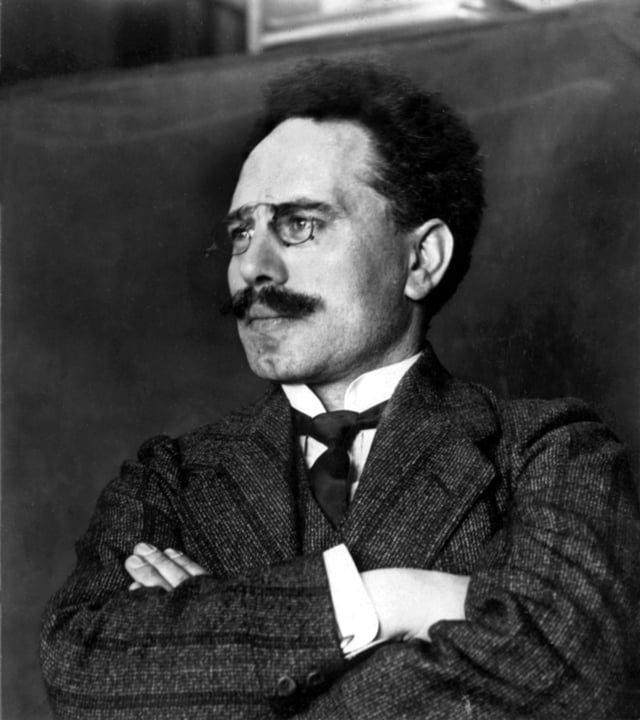
Karl Liebknecht (c. 1911)
Hans Meyer; (1858–1929), geographer, Africanist and mountaineer, first European to reach the summit of Mount Kilimanjaro
Wilhelm Souchon; (1864–1946), Vice Admiral of the Imperial Navy, commander of the Ottoman and Bulgarian Navy
Karl Liebknecht; (1871–1919), socialist politician (co-founder of the Communist Party of Germany)
Carl Friedrich Goerdeler; (1884–1945), mayor, one of the leaders of conservative resistance against Hitler
Max Beckmann; (1884–1950), Expressionist painter, professor at art academies and schools
Wilhelm Backhaus; (1884–1969), pianist
Paul Frölich; (1884–1953), politician (KPD co-founder), executor and biographer of Rosa Luxemburg
Walter Ulbricht; (1893–1973), Communist politician (SED), GDR Chairman of the Council of State from 1960 to 1973
Ruth Fischer; (1895–1961), communist politician and journalist, co-founder of the CPA
Hanns Eisler; (1898–1962), composer (inter alia of the national anthem of the GDR.)
Bruno Apitz; (1900–1979), writer (Naked among wolves)
20th century
1901–1950
Karl Eberhard Schöngarth; (1903–1946), SS officer and war criminal, executed in Hamelin, commander of the state police (Security Office) and the Security Service (SD)
Hans Mayer; (1907–2001), literary scholar
Annemarie Renger; (1919–2008), politician (SPD), President of the Bundestag from 1972 to 1976
Elfriede Rinkel; (1922–2018), former warden of a concentration camp during the Nazi dictatorship
Martin Broszat, (1926–1989), historian, head of Institut für Zeitgeschichte in Munich
Kurt Masur, (1927–2015), conductor of the Gewandhaus orchestra
Herbert Blomstedt, (born 1927), conductor of the Gewandhaus orchestra
Werner Tübke, (1929–2004), painter
Rita Wilden, (born 1947), athlete (sprinter)
Ruth Pfau, (1929–2017), nun, physician, writer( "Pakistan's Mother Teresa")
1951–present

Neo Rauch (2017)
Hans-Joachim Schulze (born 1934), German Bach scholar
Riccardo Chailly (born 1953), conductor of the Gewandhaus orchestra
René Müller (born 1959), footballer for Lokomotive Leipzig and the East German national team
Neo Rauch (born 1960), painter
Simone Thomalla (born 1965), actress
Kristin Otto (born 1966), swimmer, 6-time Olympic gold medalist, sports journalist and TV presenter (ZDF)
Matthias Weischer (born 1973), painter
Till Lindemann (born 1963), vocalist
See also
Ubiquity Theatre Company – English speaking theatre projects in Leipzig.
Leipzig Human Rights Award
List of mayors of Leipzig
Hugo Schneider AG
Leipzig University Library
Leipzig Jewish community
Battle of Breitenfeld (1642)





